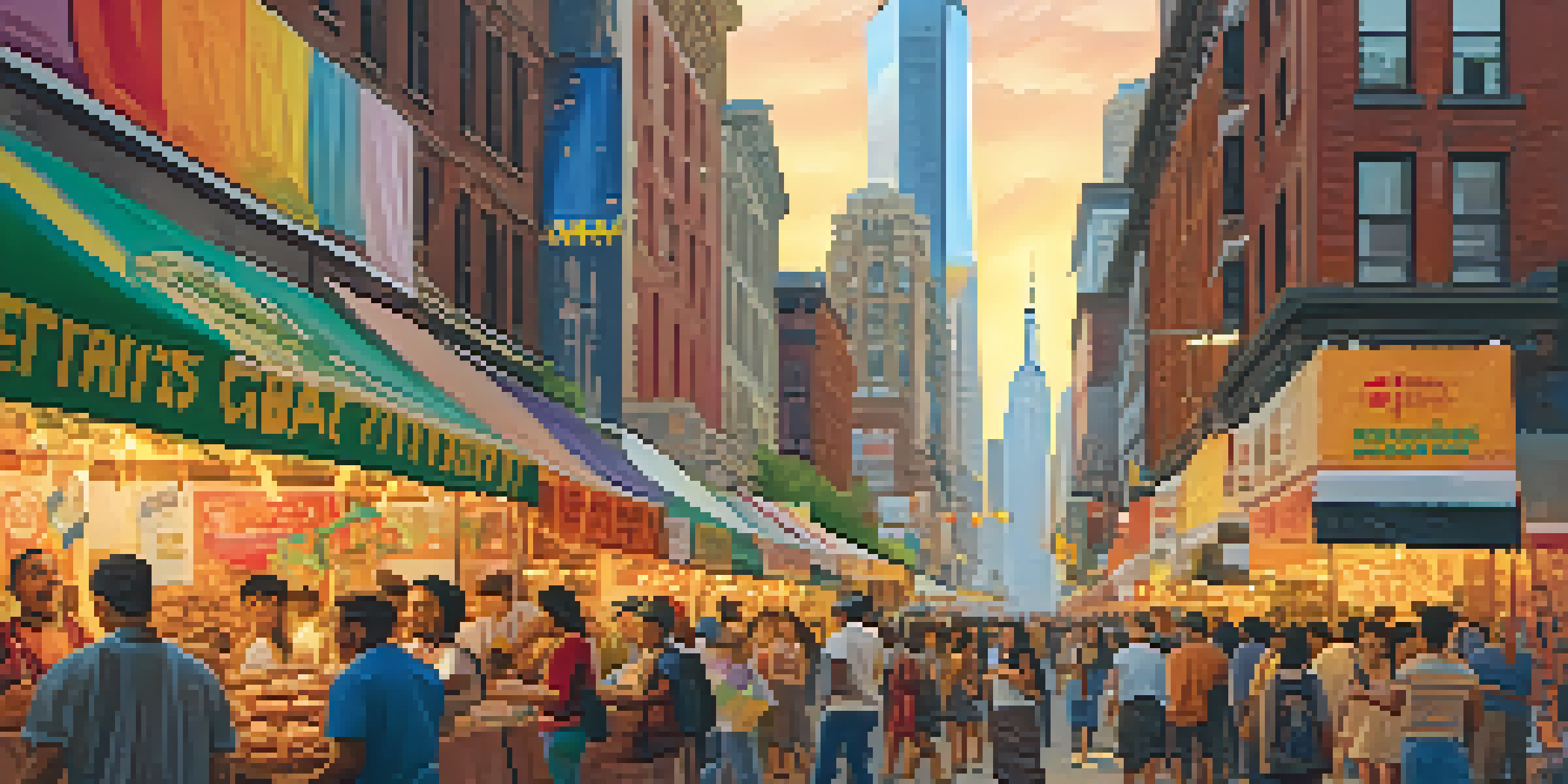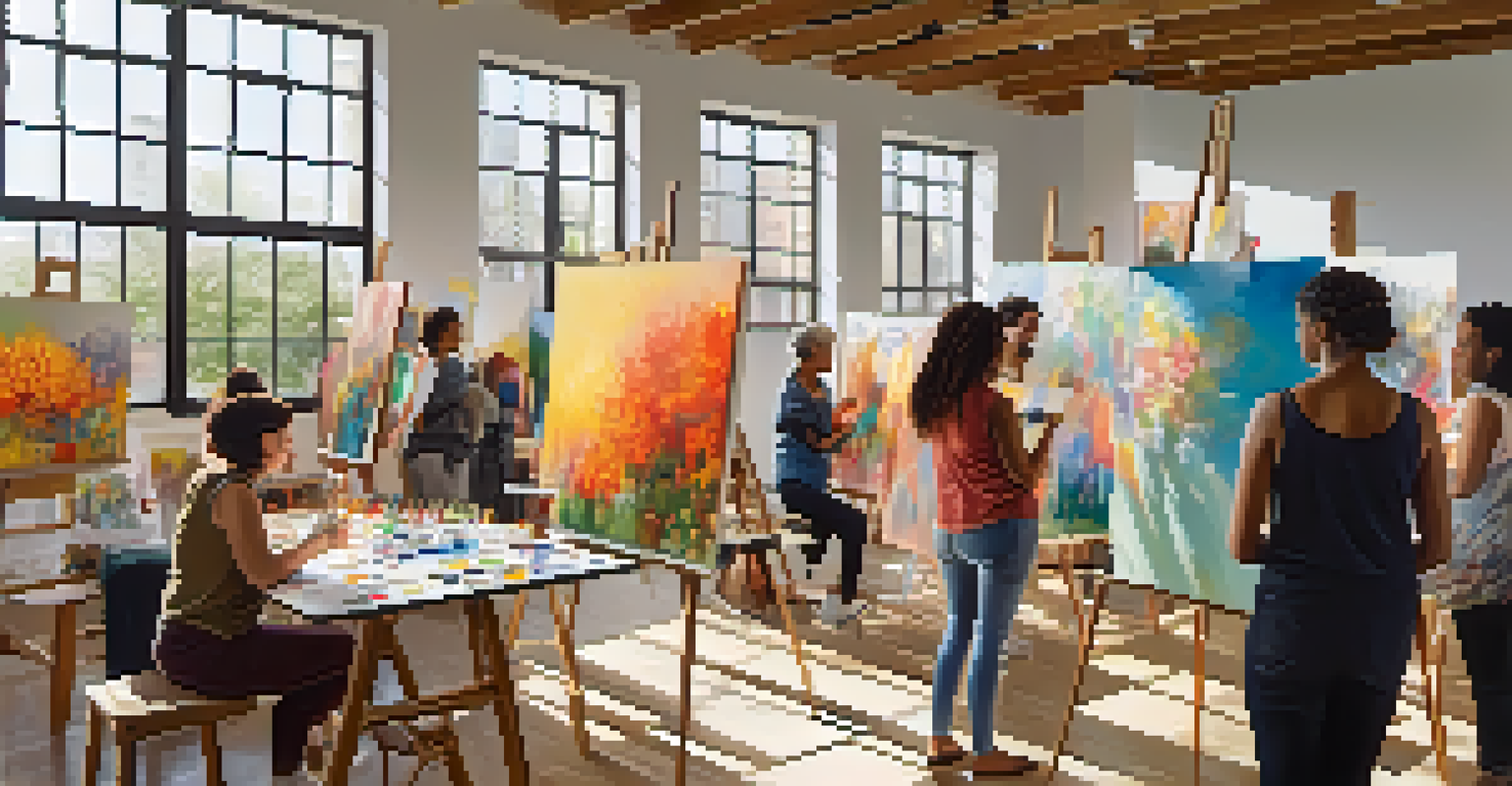Economic Inequality: A Barrier to NYC's Cultural Diversity

Understanding Economic Inequality in NYC
Economic inequality refers to the unequal distribution of wealth and resources among individuals in a society. In New York City, this disparity is particularly pronounced, with a stark contrast between the affluent and those living in poverty. The city's iconic skyline and luxury apartments coexist with neighborhoods facing high rates of unemployment and low wages, illustrating a complex social fabric.
Economic inequality is not just a problem for the poor; it is a problem for all of us. It undermines the social contract that binds us together as a society.
This inequality is not just a statistical issue; it affects the daily lives of millions. Families in economically disadvantaged areas often struggle to access basic needs, such as quality education, healthcare, and reliable public transportation. As a result, the opportunities for upward mobility are limited, perpetuating a cycle of poverty that is hard to break.
Furthermore, the high cost of living in NYC compounds these challenges, making it difficult for low-income residents to participate fully in the city's vibrant cultural scene. This economic divide not only impacts individuals but also the cultural diversity that makes NYC unique.
The Role of Cultural Diversity in NYC
New York City is famously known as a melting pot, with a rich tapestry of cultures, languages, and traditions. This diversity is not only a source of pride but also a driving force behind the city's creativity and innovation. From art galleries to food festivals, the cultural contributions from various communities enrich the city's overall experience.

However, the ability of these diverse communities to thrive and contribute fully to the cultural landscape is often hampered by economic barriers. When individuals are struggling to meet their basic needs, engaging in cultural activities—whether as creators or participants—becomes a lower priority. This creates a gap in representation and participation in the city's cultural narrative.
Economic Inequality Affects Culture
The stark economic divide in NYC limits access to cultural experiences for low-income residents, hindering their participation and representation.
Moreover, the lack of economic resources can lead to the erosion of cultural institutions that serve these communities. When funding is limited, local theaters, galleries, and cultural centers face tough choices, often leading to their closure or reduced programming, which diminishes the overall cultural diversity of the city.
Economic Barriers to Cultural Participation
Access to cultural experiences often comes at a cost, whether it's purchasing tickets to events, traveling to venues, or buying supplies for artistic endeavors. For many low-income individuals and families in NYC, these expenses can be significant barriers. When entertainment options are constrained by financial limitations, engagement in the cultural scene diminishes.
Cultural diversity is the essence of humanity, but economic barriers can choke it off before it has a chance to flourish.
Additionally, the perception of cultural events as exclusive or elitist can further alienate economically disadvantaged communities. Many individuals may feel unwelcome or out of place in environments that cater predominantly to wealthier patrons, leading to a sense of disconnection from the city's cultural offerings.
This economic barrier creates a cycle where cultural participation remains limited, perpetuating the idea that certain cultural experiences are reserved for those who can afford them. As a result, the vibrant tapestry of NYC's culture is at risk of becoming monochromatic, lacking the rich contributions from all its residents.
Community Initiatives and Solutions
Despite the challenges posed by economic inequality, numerous community initiatives aim to bridge the gap and promote cultural participation. Organizations across NYC are working to provide free or low-cost access to cultural events, ensuring that everyone has the opportunity to engage with the arts. These initiatives not only provide access but foster a sense of belonging within the community.
Moreover, educational programs that focus on the arts can empower underrepresented communities by providing valuable skills and opportunities for expression. By investing in local talent and fostering creativity, these programs help to cultivate a more inclusive cultural landscape that reflects the true diversity of NYC.
Community Initiatives Promote Access
Various community initiatives are addressing economic barriers by providing free or low-cost access to cultural events, fostering inclusivity.
Partnerships between cultural institutions and local organizations can also play a pivotal role in addressing economic barriers. By collaborating on outreach efforts and creating accessible programs, these alliances can ensure that cultural diversity is not just preserved but celebrated throughout the city.
The Impact of Policy on Economic Inequality
Public policy plays a significant role in shaping economic inequality in NYC. Decisions regarding housing, education funding, and social services directly impact the resources available to low-income communities. When policies fail to address the needs of these populations, the gap between the wealthy and the poor continues to widen.
Additionally, policies that prioritize economic development without considering the needs of all residents can lead to gentrification. This process often displaces long-standing communities, erasing cultural diversity in the name of progress. The challenge lies in finding a balance between development and the preservation of the city's unique cultural landscape.
Advocating for policies that promote equity and inclusion can help mitigate the effects of economic inequality. By prioritizing affordable housing, equitable education, and accessible healthcare, policymakers can create an environment where all New Yorkers have the opportunity to thrive and contribute to the city's rich cultural fabric.
Building a More Inclusive Cultural Landscape
Creating a more inclusive cultural landscape in NYC requires collaboration among various stakeholders, including government, cultural institutions, and community organizations. By working together, these entities can develop strategies that promote access to cultural experiences for everyone, regardless of economic status. This collaborative approach can lead to innovative solutions that foster inclusivity.
Engaging local communities in the decision-making process is crucial. When residents have a voice in shaping cultural programs and initiatives, they are more likely to feel represented and invested in the outcomes. This participatory approach not only strengthens community ties but also enriches the cultural offerings of the city.
Policy Changes Needed for Equity
Public policies must prioritize affordable housing and equitable education to mitigate economic inequality and support NYC's diverse cultural landscape.
Ultimately, fostering a vibrant cultural scene that reflects the diversity of NYC means recognizing the barriers posed by economic inequality and actively working to dismantle them. By prioritizing inclusivity, we can ensure that every New Yorker has the chance to share their unique story and contribute to the city's dynamic cultural narrative.
Conclusion: The Future of NYC's Cultural Diversity
The future of NYC's cultural diversity hinges on addressing economic inequality head-on. By acknowledging the barriers that exist and actively working to overcome them, we can create a city that truly represents all its residents. This not only enriches the cultural landscape but also strengthens the social fabric of the community.
As we move forward, it's essential to foster an environment where diverse voices and experiences can thrive. This means advocating for policies that promote equity, supporting community initiatives, and ensuring that cultural participation is accessible to all. Together, we can build a more inclusive and vibrant NYC.

In a city renowned for its diversity, the goal should be to ensure that every individual can contribute to and benefit from its rich cultural tapestry. By tackling economic inequality, we pave the way for a brighter, more inclusive future for all New Yorkers.